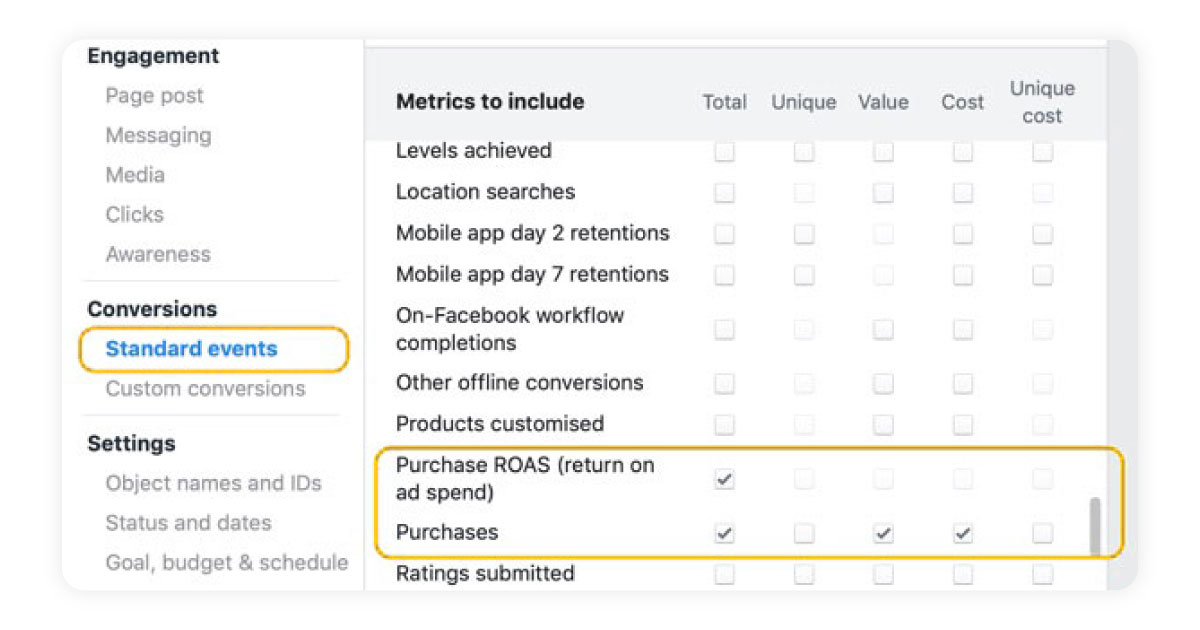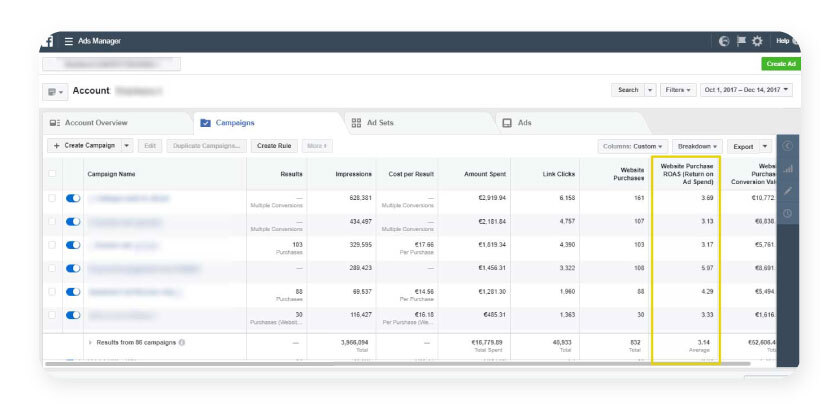What is ROAS in Facebook Ads?
If you’re involved in advertising, you’ve likely encountered the term ROAS. Return on Ad Spend (ROAS) is one of the key metrics for measuring marketing performance. It determines how much money you’ve gained from your advertising efforts across one or multiple channels. This highly-focused metric is very useful in assessing the success of your ad campaigns.
ROAS has gained much significance in the marketing world in recent years thanks to the massive growth of digital marketing platforms. Facebook, for instance, provides accurate, actionable data on your ad’s performance like click-through rate, impressions, conversion rate, etc. These stats make calculating ROAS insanely easy. In other words, you have the info you need to assess your Facebook Ads campaign’s performance. The question here is, what is a good ROAS for Facebook Ads?
How to calculate ROAS?
Despite sounding a bit of a mouthful, ROAS has a very simple formula. The metric only focuses on two aspects:
- The total amount you’ve spent on promoting your brand, product, or service
- The revenue you’ve managed to generate with your ads
All you have to do is to divide the revenue by the amount spent:
ROAS = Revenue from advertising campaigns / Cost of advertising campaigns
For example, if you spend $1000 on a Facebook Ads campaign and make $4000 worth of sales from it, your Return on Ad Spend would be 4000/1000 = 4. What this number means is that for each dollar you’ve spent on your campaign, you’ve earned 4 dollars in return.

Why ROAS matters for Facebook Ads?
ROAS is the most efficient way to evaluate the performance of your ad campaigns. It’s particularly great for organizations to figure out whether their advertising strategy is working or not. ROAS doesn’t have to be limited to a specific channel; You can calculate your overall ROAS across all the channels that you’re running ads on.
It’s worth noting that although ROAS is a major KPI, it’s not always easy to calculate it for every channel. Specifically, calculating ROAS for mediums that don’t provide a way to track campaign performance and gain actionable data (like TV, Print media, billboards, etc.) could be a challenge. On the other hand, digital platforms have no such problems. For example, Facebook can closely track every action users take on your website using the Facebook Pixel module and give you accurate reports on conversions.
Setting Your Own ROAS Goals
In the intricate realm of digital advertising, success is more than just a number—it’s a narrative woven by the delicate interplay of goals and outcomes. This holds especially true when it comes to setting your Return on Ad Spend (ROAS) goals on Facebook. Let’s embark on a journey that uncovers the art of crafting ROAS goals that resonate with your business’s unique rhythm and aspirations.
Emphasizing the Symbiosis of ROAS and Business Objectives: Picture ROAS as the compass guiding your ship through the vast seas of advertising. Like a seasoned navigator, your ROAS goals need to align with the star of your business’s objectives. Whether you’re sailing towards increased brand awareness, direct sales, or lead generation, your ROAS should be a true companion to these ambitions. When goals and ROAS dance in harmony, your advertising efforts become a symphony of purpose and profit.
Unveiling the Process of Crafting Realistic ROAS Targets: Setting ROAS goals is akin to sculpting a masterpiece—it requires precision, vision, and a touch of realism. To start, consider your desired profit margins and the level of investment you’re willing to dedicate. Imagine your business as a canvas: What shades of revenue do you wish to paint across it? Through meticulous calculation, assess the revenue you aim to generate against the cost of your ads. This calculus will unearth a ROAS target that not only beckons you forward but also keeps your feet firmly on the ground.
Embracing the Equilibrium of Short-Term Returns and Long-Term Value: In the bustling arena of advertising, it’s easy to be dazzled by the allure of immediate gains. Yet, as the wise adage goes, “Rome wasn’t built in a day.” Encourage yourself to gaze beyond the horizon of short-term profits and explore the boundless landscape of long-term customer value. A balanced perspective understands that ROAS is a thread woven into the tapestry of your business’s journey. It acknowledges that building lasting relationships with customers can yield dividends that extend far beyond a single transaction.
Walking the Path Forward: The Art of Setting ROAS Goals
- Know Your Business’s Soul: Understand your business’s identity, its dreams, and its purpose. Let these elements guide the definition of your ROAS goals.
- Blend Ambition with Pragmatism: Infuse your aspirations with a touch of reality. Combine desired profit margins with investment capacity to shape achievable ROAS targets.
- Cherish the Long-Term: While the present is important, remember the enduring power of customer loyalty. Factor in the lifetime value of customers to paint a holistic picture.
- Iterate and Adapt: Just as an artist refines a masterpiece, refine your ROAS goals over time. Adapt to changing market dynamics, feedback, and emerging opportunities.
In essence, setting your own ROAS goals is an odyssey of intention and calculation. It’s a voyage where your business objectives and fiscal aspirations converge, where immediate returns are complemented by the promise of lasting value. By crafting ROAS goals that echo the heartbeats of your business’s narrative, you’ll chart a course that’s uniquely yours—a journey illuminated by purpose and illuminated by profit.
And now the big question…
Now that you have a good understanding of ROAS and its benefits, let’s talk about the benchmark you should set for it. It’s important to know that “good ROAS” is not definitive. It heavily depends on the channel you’re utilizing in your strategy and your vertical. Several other factors can also impact your criteria like margins, financial status, and operating costs.
The campaign objective is another influencing element that you should consider when judging your ROAS. If you’re running ads on Facebook to build brand awareness and boost your visibility, your ROAS would obviously be much lower than with ads that focus on making sales. Generally speaking, try to aim for at least $4 ROAS (four times your original investment).

What about ROI?
ROI or Return on Investment is another major performance measure that’s frequently mistaken with ROAS. This metric is much broader and evaluates how well an overall investment has performed, whereas, in ROAS, advertising performance is the point of concern. Here’s how ROI is calculated:
ROI = ((Value of investment – Costs of investment) / Costs of investment ) x 100
As you can see, ROI takes all the expenditures into account. This means that when calculating ROI, you must factor in the costs of operating, software, employees, shipping, etc. alongside ad spend. Keep in mind that ROAS and ROI are definitely not equivalent and sometimes, these two are even opposed to each other. Let us elaborate:
Company X earned $10,000 in a month after the launch of a new product. Promoting the product via Facebook Ads has cost them $5,000 and an additional $6,000 was spent on production, shipping, and personnel. The ROAS for this month would be:
ROAS = 10000 / 5000 = $2
In other words, Company X has made twice the money they’ve spent on promoting their new product on Facebook. Looks pretty good, right? Now let’s calculate the ROI:
ROI = ((10000-(5000+6000))/11000) x 100 = -9%
As you can see, even though the ad campaign has achieved a positive result, the overall investment has not been profitable at all.
ROAS vs ROI
You’re probably wondering which one to use in your assessments and when. It’s clear that ROI is good for measuring the overall profitability of your investments. It gives you a good idea of how well your long-term business strategy is working. On the other hand, ROAS only determines if your ad campaigns are successful or not and It’s more useful in the short or mid-term.
If you want to start collaborating with a third-party advertising agency or prepare a new Facebook marketing campaign for the first time, be careful when asking the question “what is a good ROAS for Facebook Ads”. Each performance metric must be looked at from the unique perspective of your business, especially ones like ROAS that could be deceiving. I’ve seen so many entrepreneurs complaining about suffering heavy losses from ad campaigns that looked like they were generating good results, but not good enough to cover the collective costs of investments.
It’s crucial to calculate ROAS for your ad campaigns both separately and collectively. By knowing this metric, you can figure out which campaigns are getting satisfying results, which ones need more tweaks, and which one should be scrapped altogether. It’s also effective in evaluating your advertising strategy in general and helps you make smarter choices on where and how to spend your advertising budget.

Tips to maximize ROAS for Facebook Ads
ROAS measures the overall performance of your ad campaigns. Therefore, in order to achieve a sustainable ratio, you need to follow a well-thought-out strategy and check all the [numerous] empty boxes. Whether you’ll get a good ROAS heavily depends on how optimized your ads are in terms of targeting, bidding, copy and creative, landing page design, and several other factors which are beyond the scope of this article. But here are some quick useful tips that’ll give you a good idea of how you can boost your ROAS and ROI:
- First of all, be careful when setting goals and objectives. Each campaign has its own purpose that directly affects how much value it would bring to the company. Define realistic ROAS benchmarks based on your financial status, campaign objective, and advertising channel so you’re not left high and dry when ads underperform.
- Run campaigns according to your marketing funnel. Customer acquisition is a process. You shouldn’t expect to just start shouting a product’s name out of the blue in the audience’s face and expect them to become your customers without prior knowledge of your brand. Begin by building awareness and introducing yourself to them. After you caught their attention, retarget and entice them to click on your ad and make purchases with exciting ads and interesting offers.
- Take advantage of Facebook’s ROAS Goal feature. ROAS Goal is a bidding option that utilizes Facebook’s automated system to achieve an average ROAS during the course of your campaign. Contrary to the Highest value option which spends your entire budget by the end of the campaign’s lifetime, ROAS Goal aims to get you the best results possible while staying around the ROAS value you set. This means that ROAS Goal might not fully spend your ad budget.
- Each ad in your campaign has several aspects that optimizing significantly increase your chances to get high returns. The essential ones would be the creative you use, the copy you write, the landing page you use, and the people you target. Pro marketer or not, getting a full grasp of all of these aspects is challenging, time-consuming, and expensive. The smart move here would be to get observe how powerful players in your niche are handling their Facebook Ads. This is possible – and incredibly easy – via Facebook Ads spy tools like AdFlex, which lets you search and find the most successful ads and get inspiration from them.
FAQ
What is Facebook Ads ROAS?
ROAS, or Return on Ad Spend, is a key performance metric that evaluates the effectiveness of your paid acquisition efforts across different channels. To calculate ROAS, you divide the revenue you got from running ad campaigns by the amount you spent on them. For example, if you spend $2,000 on a Facebook Ads campaign and make $10,000 off of it, your ROAS would be $5. This means that for every dollar you spent on your campaign, you earned five dollars back.
What is ROI?
ROI is a major business KPI that focuses on assessing the profitability of an investment. It’s a much broader metric than ROAS since it factors in all expenditures like personnel, software, shipping, operating, and production costs in addition to ad spend. To calculate ROI, subtract total costs from revenue, then divide it by total costs. ROI is mostly expressed in percentage.
What’s the difference between ROAS and ROI?
ROAS and ROI are commonly mistaken for each other, but they’re not equivalent at all. ROAS only evaluates the efficacy of your paid promotion efforts like social media ads or print ads. ROI on the other hand is more general and focuses on the overall profit you made by an investment. Positive ROAS does not guarantee positive ROI and only shows that you made more money from ads than the amount you spent on them.
What is a good ROAS for Facebook Ads?
There’s no definite answer to this question because it heavily depends on several factors unique to your brand. First of all, ROAS for every vertical is different. The financial status of your business alongside the advertising channel you choose and the campaign objective you set influences your ROAS benchmarks. For Facebook Ads, it’s generally said that making four to ten times the money you spend on running campaigns is reasonable.







 Facebook Ads Spy Tool
Facebook Ads Spy Tool TikTok Ads Spy Tool
TikTok Ads Spy Tool
3 thoughts on “What’s A Good ROAS For Facebook Ads? Learn About Return On Ad Spend”
Based on my personal experience a good rule of thumb for ROAS is:
If your ROAS is less than 3:1, reconsider your ad campaign. You are probably losing money.
With a ROAS of 4:1, chances are your ad campaign will turn a profit.
If your ROAS is 5:1 or higher, everything is going well.
Naturally, achieving a successful relationship is easier said than done.
Hi Javier Thanks for your comment. It really depends on the businesses and the goals they have in mind for their advertising campaigns, how they manage their budget, and how much revenue they’ve been expecting to make.